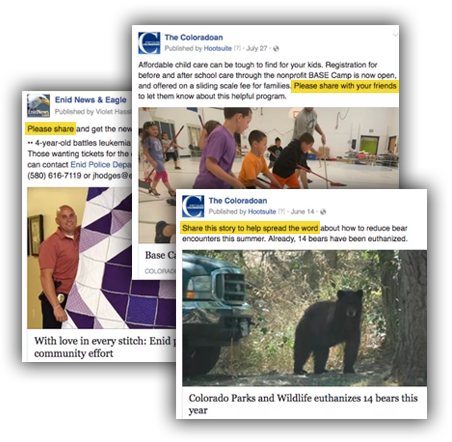 DESCRIPTION: Specifically encourage sharing, as a part of healthy contributions to their social networks’ information diets. Invite users to make a relationship with you part of their social identity, and to join you in your mission to make the world better informed. METRICS: Watch for reactions and shares. Follow the shares (when they’re public) to see reactions from those wider networks.
DESCRIPTION: Specifically encourage sharing, as a part of healthy contributions to their social networks’ information diets. Invite users to make a relationship with you part of their social identity, and to join you in your mission to make the world better informed. METRICS: Watch for reactions and shares. Follow the shares (when they’re public) to see reactions from those wider networks.
 This strategy focused on directly encouraging followers to share our posts with their own networks. This summer was the perfect time to be testing this particular strategy, given Facebook’s announcement that it would rank friends’ posts higher than page posts.
This strategy focused on directly encouraging followers to share our posts with their own networks. This summer was the perfect time to be testing this particular strategy, given Facebook’s announcement that it would rank friends’ posts higher than page posts.
NOTE: This testing was done in 2016. Facebook best practices around sharing have changed, so some recommendations will be outdated.
The eight newsrooms that tested this strategy had success in emphasizing why users might want to share certain types of stories. The most successful examples were ones that framed posts in ways that emphasized the “pass this along” factor and recognized users’ potential motivations for sharing. You’ll see examples of where the journalists could have merely described a story but instead stated explicitly why someone might WANT to share it, or who they might want to share it with. It worked well to ask users to think about who they want to explore the hiking trails with and who they know who has a Yahoo password. Users again and again showed a willingness to help share positive news.
In some cases, the highly successful posts were what you might expect, with stories that users would be inclined to share anyway. In some cases, word choices and the framing of the post made a story more shareable than it might have otherwise been. This St. Louis Magazine post on segregation, for example, is written in a way that makes sharing feel like something a responsible, aware resident should do.
Deploy your fans: What worked especially well?
KEY TAKEAWAYS:
- Encourage sharing on posts and topics users will WANT to share, not ones you WISH they would share.
- Start with easy asks (posts that are obviously helpful, positive or fun).
- Invite sharing on posts that are in the public interest. When police need help finding a missing child, or a food recall endangers peoples’ health, lots of users will see it as a civic duty to help spread the word.
- Emphasize emotion when appropriate. If users are likely to share because they’re proud, outraged, scared or excited, consider whether the framing of your post includes that angle.
Here are some especially successful examples of this strategy, organized by topic. The examples are mostly posts that were successful in terms of user engagement (the number of shares or comments with tags). We also included posts that didn’t get as much engagement but that we think were successful examples of the strategy and should be repeated.
- Hot topics: Stories that call out to be shared and talked about.
- Utility news: Posts that help people live their everyday lives.
- Public safety: Posts that involve crime and safety.
- Public health: Posts related to issues of physical or mental health
- Leisure: Posts that help people (and their friends!) figure out what to do, eat or drink. (RELATED: See the Host Meaningful Conversation results for more on posts like this.)
- Community spirit: Posts that celebrate good things in the community or invite togetherness around hard things.
- Pets: Posts that invite people to help animals in need.
What didn’t work?
- Posts that feel like assignments. The Coloradoan asked users to “share an editorial with their friends and talk about how to respect human life.” That’s a big ask. It’s a weighty subject with a very broad question attached.
- Posts that are so general they’re not useful. Newsy asked users to get and share the facts about Trump and the RNC. Because that sounds like it covers so much, it doesn’t give users a specific jumping-off point. It also doesn’t offer anything to react to. It’s a label, not a story.
- Posts that are late to the game. Why did Fort Worth get 850+ shares on its post about Yahoo passwords but Fresno got just one? One reason: Fresno’s was a day later. The conversation had moved on.
- Posts that pinned engagement on topics people don’t necessarily talk about publicly. In a post about a job fair, WCPO invited users to tag friends who are job-hunting, something people aren’t always open about. The Coloradoan asked people to share a post with friends who can’t afford child care. Perhaps the posts were shared privately, but they’re not going to be topics people discuss with their whole networks.
- Posts that asked users to call out friends with unpopular opinions. Some users surely want to publicly accuse a friend of narrow-minded views on Muslims, but it’s likely a small group.
Tips on writing styles and framing
Try adding simple words: There are lots of ways to encourage sharing. Some newsrooms had great success (on certain topics) with adding a simple “share the news” or “spread the news” to a post. The Enid News and Eagle found their audience followed those directions quite well.
Emphasize the public interest: Make sure not to make the post about you. Don’t ask people to help spread your really great story. Ask people to make sure their friends know about this very important thing.
Tagging friends is a form of sharing: Ask people who they want to hike with, and they’ll often respond by tagging friends in the comments. Invite people to have specific friends in mind. Know people who love craft beer or Garth Brooks? Know people who qualify for this free meal or might be interested in free school supplies? Or any pregnant women, as highlighted in this post with 3,500+ shares? Share this post with them or tag them in a comment.
Call to mind to a higher purpose: St. Louis Magazine had great success in a post by appealing to a desire for informed conversations about race relations. Other wording options: Help us educate people. Or help set the record straight. These sometimes didn’t work, too. Here’s one we thought would work, inviting users to combat misinformation.
Be human: Remember that one of the reasons the project focused on sharing is users often trust their friends and family more than they trust brands. So in encouraging sharing, it can be especially effective to write like a human being — informally and with emotion. Posts like this one about Alzheimer’s from the Kansas City Star are humanized when they use language like “this horrible disease” rather than just focusing on the research.
Here’s a list we circulated on the project’s Slack team for wording ideas.
- What about appealing to a shared goal? Like … Wouldn’t it be great if the facts of this story were shared as widely as the finger pointing? Or … In the middle of the hype around this issue, the facts seem to be getting lost.
- We wish more people understood this.…
- Do you know anyone who’s got this wrong …
- Who do you know who needs to read this …
- Help us educate people by sharing this …
- Help us spread the word …
- We know there’s confusion about this. We can help explain …
- We thought you might also be wondering about this …
- Or a specific group … Teachers, are you still confused about …
- Let’s make this conversation bigger. Share with someone you know who …
- We can’t be the only ones who think this needs more attention …
- So and so said people don’t understand this. Let’s change that.
- Share if you wish more people understood …
- Share if this issue has affected you …
- Share if you want to help raise awareness about …
- You may not be a public figure, but you still have a microphone. Help us keep our community informed and accountable.

